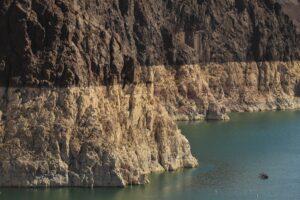
Lake Mead – Photo Credit: LATimes.com
While we often are focused on the Rio Verde Foothills as the main water story locally, but in reality the drought supercycle that has impacted the Colorado River, and thus Lake Mead and Lake Powell (representing Arizona’s water supply) had been the preeminent local story in the run-up to the Rio Verde Foothills crisis. Now that the crisis in the Foothills seems to be largely resolved, our larger water supply issues may be coming back into the forefront.
It had been a very positive spring and summer insofar as melting snowpack is related, with huge increases in the water levels at both lakes resulting from a far above-average snowpack melt. After several down years with lake levels consistently dropping, it has been an extremely positive and much needed development. But all good things must come to an end, and recent data shows that after a five month surge, water levels at those lakes have receded some.
While those levels usually recede in the late summer and into the winter every year, we are still left with plenty of questions. The biggest question? Was this winter of high snowfall and plenty of subsequent run-off a one year aberration within a large drought supercycle, or the beginning of a trend of wetter winters?
First, let’s get the obvious out of the way…it’s nearly impossible to predict the weather two weeks out, let alone for the next 12 months or more. That said, it appears as though the La Niña weather pattern is over; they typically bring additional snow to the southern Rockies, which may have contributed to the outperformance in snowpack this year. It’s not unreasonable to believe that the drought supercycle is set to return.
So what is at stake? We probably don’t need to tell our regular readers, but our entire way of life hangs in the balance. Scottsdale has done its best to get in front of this issue, limiting natural lawns for front yards, but this will be a drop in the bucket compared to what may come in the future. Our farming industry may be the first major shoe to drop, considering how water-intensive it is. Tourism may be impacted in the future as golf courses are seen as luxuries and our brand takes a hit due to repeated water cutbacks.
Unfortunately, all we can do is wait and see what the next few years hold for us and monitor the water levels at Lake Mead and Lake Powell as time goes on. If the previous trends resume, our state could irrevocably change.

